Mary Hoffman's Blog, page 12
November 30, 2012
Adding badgers to the mix
Following on from my last post, if you put Wind in the Willows, here are some badgers for you:
http://yousend.it/U6yMku
"The badgers in the footage were in for rearing, they would have come in individually as orphaned cubs, but then mixed into this group when moved to the paddocks as part of the rehabilitation process, getting them ready for their life back in the wild, They would have been released back to the wild as this group"
http://yousend.it/U6yMku
"The badgers in the footage were in for rearing, they would have come in individually as orphaned cubs, but then mixed into this group when moved to the paddocks as part of the rehabilitation process, getting them ready for their life back in the wild, They would have been released back to the wild as this group"
Published on November 30, 2012 11:01
November 20, 2012
Favourite animal books
 The delightful Mary Plain by Irene WilliamsonThe RSPCA emailed me about a competition they are having and asked me to write about my favourite animal book when I was a child. It's very hard to think of just one. It wasn't my first book but I loved Gwynedd Rae's stories about Mary Plain, who was a bear cub from the "bear pits at Berne." (I had no idea what that meant).
The delightful Mary Plain by Irene WilliamsonThe RSPCA emailed me about a competition they are having and asked me to write about my favourite animal book when I was a child. It's very hard to think of just one. It wasn't my first book but I loved Gwynedd Rae's stories about Mary Plain, who was a bear cub from the "bear pits at Berne." (I had no idea what that meant).Mary had so much character. Her best friend was The Owl Man, known thus because of his large horn-rimmed glasses. The Owl Man had a friend called Fur Coat Lady, but neither Mary nor I wondered whose fur it had been before. The little bear was very fond of cream buns though if she ate too many could fear she was going to be "untidy."

Before Mary Plain, I had been hooked on the Mary Mouse books by Enid Blyton, with their odd small landscape format. At the opposite end of the size spectrum came Kathleen Hale's giant Orlando books:

Really nothing else could do justice to the overwhelming glamour of a large and handsome ginger Tom. Orlando's home life showed him as very much the boss of the operation, with his wife always in an apron and doing domestic chores.
Orlando was the breadwinner (?mousewinner) though I do remember one book (?Orlando goes Camping) in which the adult cats and kittens partook heartily of watercress - a rather unlikely food for felines but I'm sure Kathleen Hale enjoyed painting it.
Another favourite was Sam Pig and Sally by Alison Uttley though I can't remember any of the stories now.
I didn't really get on with Wind in the Willows and feel no nostalgia for it. Peter Rabbit I don't remember having at all and yet I seem always to have known those little child-friendly square hardbacks that Frederick Warne produced of Beatrix Potter's stories.
There was no Roald Dahl when I was a child - perhaps I should like him better if there had been - and no Dick King-Smith or Michael Morpurgo - whom I would have enjoyed more.
But in the RSPCA's survey, Dahl's Fantastic Mister Fox came out top of the favourite animal books remembered by adults aged 16-64 this September, with Wind in the Willows coming second and Beatrix Potter's books in general coming third.
The survey was linked to the writing competition Wild About Britain. There are two age categories in the competition to write a short story about a British wild animal (no bears or ginger cats) – 11 years and under and 12 to 16 year-olds. The closing date for the competition is midnight on Monday 10 December 2012 and the winner will receive a selection of books from Random House publishers and be published on the website. The full judging panel is to be confirmed but will include Chris Packham.
Full details are here: http://www.wildaboutbritain.org.uk
And what was your favourite animal story when you were a child?
Published on November 20, 2012 10:31
November 9, 2012
Ailurophobes, look away now!
 I'm an unashamed cat lover, but I've never had a ginger, though I find them deeply attractive. Jackie Morris, on the other hand, has had lots. And, as is the way of it with cat owners, she has lost many over the years too. This gorgeous, quite large-format picture book was inspired by one of them: Pixie.
I'm an unashamed cat lover, but I've never had a ginger, though I find them deeply attractive. Jackie Morris, on the other hand, has had lots. And, as is the way of it with cat owners, she has lost many over the years too. This gorgeous, quite large-format picture book was inspired by one of them: Pixie.The ginger curls up "ammonite tight" on her patchwork cushion and dreams of her bigger cousins, from the tiger, "bright flame cat of the forest" to the Scottish wildcat "ancient, almost a memory." The artwork is stunning and the text lyrical and there is a spread at the end with all the natural history details of the elegant felines. A must for every cat-lover, but you'll have to get your own; I'm not parting with mine.
Ginger cats have been getting almost as much coverage in the media and on social networks as a certain transatlantic event. Two candidates have been vying for the title of (The) Tobermory Cat. One is a photographic book by Angus Stewart and the other a picture book by Debi Gliori.
I had read so much online about Stewart's claims of plagiarism and Gliori's being cyber-bullied by people who thought that Stewart had invented this feline that I bought both books. (I like to know what I'm writing about).


And really you know they just aren't the same kind of book at all. I loved looking at all the photographs of the (apparently) composite cat in Angus Stewart's book. He (they) is clearly a real character. It makes a lovely album.
But Debi Gliori's is telling a story, a made-up story, for younger children about finding a way to be special. It's not an Obama/Romney kind of choice at all. I'll keep them both.
But that's not the end of my cat stories! I have been catching up with a bit of a backlog and I hadn't come across Puss Jekyll and cat Hyde before. The text is a poem by Joyce Dunbar and the illustrations are by Jill Barton, whose work I didn't know.

It's a simply premise, recognisable to every owner, that domestic cat has two distinct personalities: the cuddly, purry, wanting its tummy tickled delightful companion and the fierce and solitary hunter. Eleanor Farjeon caught it in her poem Cat: "Sleeky flatterer/ Spitfire chatterer." And Dunbar does it here too.
My only worry would be that the Jekyll and Hyde allusion will be lost on children.
I must end with another Jackie Morris book, one so beautiful that it seems impossible paper and card could contain so much magic.
 The reproduction of the cover here doesn't do it justice; the colours are much richer and the detail sharper. This book is currently nominated for the Kate Greenaway Award and I'd love it to win. Collection of Nursery Rhymes or Stories are often called "treasuries" - I've done one myself - but this one does feel like entering a secret room full of unimaginable precious objects.
The reproduction of the cover here doesn't do it justice; the colours are much richer and the detail sharper. This book is currently nominated for the Kate Greenaway Award and I'd love it to win. Collection of Nursery Rhymes or Stories are often called "treasuries" - I've done one myself - but this one does feel like entering a secret room full of unimaginable precious objects.Forty simple and familiar rhymes are transformed by Morris's alchemy into full blown stories through her art. The fine lady who rode to Banbury Cross for example has not just rings on her fingers but a hawk on her wrist (I suspect the correct Merlin); not just bells on her toes but a train of minstrels including one playing two recorders at once like the musician in Simone Martini's Knighting of St Martin fresco in Assisi.
The girl in Lavender's Blur rides a polar bear! And we ride to Babylon with a winged lion and a winged horse. Giant cats and giant sheep - nothing is what you expect. Weasels swarm and kiss and stir the rice and treacle - oh I can't go on; it is just too gorgeous for words. Give the woman a prize and give the book to every child you know. I WISH I'd had it when I was a little girl.
Published on November 09, 2012 13:48
October 29, 2012
Proud to wear the T-shirt by Mary Hoffman

Assembled here this morning in Victoria Embankment Gardens: Left is Cressida Cowell, who had left her dragon at home, centre Philip Ardagh, who had brought his beard with him and right is Francesca Simon who was not being at all horrid (this does not describe their respective political stances). They were gathering for the Mass Lobby on Parliament for School Libraries.
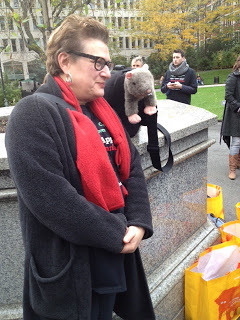
Here's another luminary: Meg Rosoff. You can just glimpse her T-shirt and the yellow bags hold more. Other writers who were there were Chris Priestley, Candy Gourlay and me. (I'm bound to have forgotten someone).
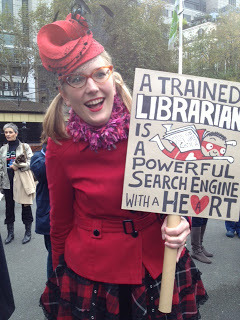 Of course! Sensational illustrator Sarah McIntyre, with her own design of banner. I hear author An Vrombout was there too.
Of course! Sensational illustrator Sarah McIntyre, with her own design of banner. I hear author An Vrombout was there too. Me, An Vrombout, Cressida Cowell, Philip Ardagh, Francesca Simon, Sarah McIntyre, Meg Rosoff
Me, An Vrombout, Cressida Cowell, Philip Ardagh, Francesca Simon, Sarah McIntyre, Meg RosoffThis brilliant lobby was organised by Barbara Band, Vice President Elect of CILIP, and her helpers. Those of us attending were to have contacted our MPs and make an appointment to meet them in the Central Lobby of the Houses of Parliament. But mine is David Cameron, so I was not hopeful this would work.
 Eventually we were ready to set off (that's Meg again, now holding a banner). We walked along the embankment to Westminster.
Eventually we were ready to set off (that's Meg again, now holding a banner). We walked along the embankment to Westminster.
Barbara Band is on the left. On the way, the chant was suggested of:
Children are extraordinaryMake school libraries statutory
but I vetoed that one on the grounds it would sound as if librarians and authors did not now how to spell "statutory."
Meg suggested changing the first line to "What kids need is lots of story" and we had offers of "Here we are in all our glory." I thought maybe, "Don't bring up our kids as fools/Put a library in their schools."
But funnily enough, we had arrived at the Houses of Parliament by then and no chanting took place. I shouldn't have objected to the first one - nobody likes a pedant.
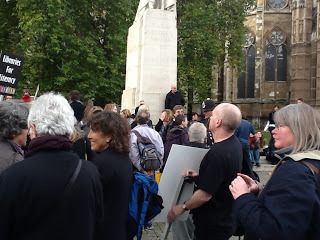 We had to stand by a statue across the road from the House of Commons and wait to to be told where to go. Strict security operated and we were let in by batches of about twenty (there were 120 or so on the march). The airport style scanner revealed a dubious object in my bag, which turned out to be my reading light for the homeward journey.
We had to stand by a statue across the road from the House of Commons and wait to to be told where to go. Strict security operated and we were let in by batches of about twenty (there were 120 or so on the march). The airport style scanner revealed a dubious object in my bag, which turned out to be my reading light for the homeward journey.The police were charming and helpful and sympathetic to our cause. as soon as we were inside, we were directed to the café and loos but most of us heading off to the Central Lobby between the house of Commons and the House of Lords.
 Image by Jorge Royan under Creative Commons
Image by Jorge Royan under Creative CommonsThere the staff were, by contrast with the police, unfriendly, offhand and aloof, leaving us all quite sure who the "plebs" were. I filled in a green card for Dave, my local MP but he didn't come out. I suppose he was busy running the country. But it was exciting to hear people's names called to meet their MPs - Bill Cash, David Milliband, Michael Gove, Diane Abbott.
Indeed, Bill Cash told his Lobbyist that he was going to draft an Early Day Motion about makes school libraries statutory! And this happened, according to Barbara: "we had a meeting with Liz Truss (which also involved Annie Mauger and other CILIP staff) .... and the outcome is that the Minister has commissioned the All Party Parliamentary Group (APPG) for Libraries to lead an investigation into the benefits of school libraries."Result! It's a no-brainer really, isn't it? If you want a literate society, put a well-stocked library, run by a well-informed qualified librarian into every school.
And the T-shirt?

It was a brilliant day and I'm still wearing my T-shirt. There are bound to be other occasions when it will come in handy.
(T-shirt photo and authors' group photo shamelessly nicked from Facebook; all others taken by me)
Published on October 29, 2012 14:43
October 19, 2012
It's Grimm down south
I am very slow on the uptake, I think. I recently reviewed a rather good adventure story for the Guardian, called The Grimm Legacy by Polly Shulman. Then I saw and heard everywhere that Philip Pullman had done a re-telling of fifty of the best Grimm Tales.

But it wasn't until I had my weekly email from We Love this Book today, featuring yet another re-telling of the doughty German siblings' output, that the penny dropped.
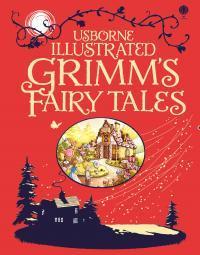 by Ruth Brocklehurst and Gill DohertyIt is 200 years since the Brothers Grimm published their Kinder- und Hausmärchen, containing 86 stories, some of which are now so familiar we think we have always known them. One of my very favourite stories ever was recorded by Jacob and Wilhelm Grimm: The Twelve Dancing Princesses.
by Ruth Brocklehurst and Gill DohertyIt is 200 years since the Brothers Grimm published their Kinder- und Hausmärchen, containing 86 stories, some of which are now so familiar we think we have always known them. One of my very favourite stories ever was recorded by Jacob and Wilhelm Grimm: The Twelve Dancing Princesses.
And by a huge coincidence, my latest re-telling of the story was published this month:

This was a very nice commission from Barefoot Books, to provide a text to go with the mysterious and atmospheric artwork of French illustrator Miss Clara. And maybe it had something to do with that bi-centenary, Durr!


But it wasn't until I had my weekly email from We Love this Book today, featuring yet another re-telling of the doughty German siblings' output, that the penny dropped.
 by Ruth Brocklehurst and Gill DohertyIt is 200 years since the Brothers Grimm published their Kinder- und Hausmärchen, containing 86 stories, some of which are now so familiar we think we have always known them. One of my very favourite stories ever was recorded by Jacob and Wilhelm Grimm: The Twelve Dancing Princesses.
by Ruth Brocklehurst and Gill DohertyIt is 200 years since the Brothers Grimm published their Kinder- und Hausmärchen, containing 86 stories, some of which are now so familiar we think we have always known them. One of my very favourite stories ever was recorded by Jacob and Wilhelm Grimm: The Twelve Dancing Princesses.And by a huge coincidence, my latest re-telling of the story was published this month:

This was a very nice commission from Barefoot Books, to provide a text to go with the mysterious and atmospheric artwork of French illustrator Miss Clara. And maybe it had something to do with that bi-centenary, Durr!
Published on October 19, 2012 09:48
October 7, 2012
What are little girls made of?

 I am going to try and write this whole post without using the word "feisty"! For a long time now, books published for the 7-11 age range have been broken across gender lines and the most egregious examples are anything originated by Working Partners.
I am going to try and write this whole post without using the word "feisty"! For a long time now, books published for the 7-11 age range have been broken across gender lines and the most egregious examples are anything originated by Working Partners.After the huge success of Rainbow Fairies by "Daisy Meadows" (now up to a 100 titles) they launched into Beast Quest by "Adam Blade" to perform the same magic for boys.
That says it all really: young girls = fairies, glitter, pink, rainbows and all things lovely; young boys = adventures, fighting and defeating curses. These series are written by a committee of different writers to a very tight brief and are nothing like the kind of books that grow out of the interests and passions of an individual creative writer.
So it is very refreshing to turn to two new books by writers who, without any sense of strain, are producing series which naturally feature forceful and resourceful heroines who have no intention of letting the boys have all the fun and adventures.
The Emerald Quest is the first in a projected series of six titles in a series called Dragon Child, which might have been written to demonstrate how the Beast Quest idea works just as well with a girl in the main role.
Tia has been brought up by dragons but can just remember being kidnapped from her human father while her mother was away. And she fears that her mother might be one of the six High Witches, sisters in magic, who have stolen a necklace with supernatural powers from the DragonQueen. Goaded by jeers from a young dragonet, Tia sets out to retrieve the jewels and prove she is a true DragonChild.
Each book will follow the adventures of Tia and her foster-brother, the dragon Finn, as they steal back each of the jewels. The emerald gives the power of understanding animal language and is in the clutches of terrifying with Malindra, who is a cross between Cruella de Ville and the three witches in Neil Gaiman's Stardust.
There are some genuinely scary and throat-parching moments along the way and Tia doesn't get her way easily but she is a very engaging new role model for any girl tired of soppy princesses.
So is Rhianna Pendragon, who has reached the second book in Katherine Roberts' Pendragon Quartet, The Lance of Truth. Rhianna, who is King Arthur's daughter, also has magical objects to collect: she won Excalibur in The Sword of Light and is now fiercely determined to gain the next totemic item. Like Tia, Rhianna has a male companion to go with her on her quest, making sure that the books are equally enticing for male readers. Rhoanna's is an Elvish prince and they both ride mist-horses, who are the author's invention.
The kind of witchcraft Rhianna Pendragon has to battle is even darker - that of Morgan le Fay, who is supposed to be dead, and her ingeniously evil son Mordred. In this book Rhianna is reunited with her mother, Guinevere, but the Queen is somewhat disappointed in her daughter. She would prefer the kind of princess who is more interested in beautiful dresses than in swords and horses.
Well, Guinevere, I can't agree. I like Rhianna and Tia just as they are. Long live the adventurous girls - who are certainly not made of "sugar and spice and all things nice."
Published on October 07, 2012 05:16
September 22, 2012
A weekend with mates
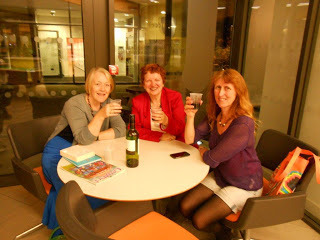 Photo by Helena Pielichaty
Photo by Helena PielichatyDon't we look as if we're having fun? And we really were, in spite of quite bad wine (which the bar ran out of after the first night), canteen food and miserable microphones. But we didn't go for any of those things; we went to meet each other and to talk. I am here flanked by Katherine Langrish and Anne Rooney, two writers who are among my favourite people to talk to.
We were at the Children's Writers and Illustrators Group (CWIG) conference, held this month at Reading University. These conferences happen irregularly, about once every three years. I've been to them at Brighton, Leeds, Oxford (the year I was Chair, handily) and Cambridge. And now Reading. This one was called Joined-up Reading but I can't remember the names of any others.
It was opened by the marvellous Kevin Crossley-Holland, who is the new President of the Schools Library Association and closed by the equally marvellous Allan Ahlberg, of whom more anon. There were 130 of us for the whole weekend and 70 day delegates on the Saturday. All writers and illustrators, apart from a few speakers from publishing or the book trade. It was a gathering of published practitioners from Helen Craig to Sally Nicholls, Prizewinners to Midlisters, all eager to talk about the state of our very peculiar industry and our place in it.
Lots of us have already blooged about it: Helena Pielichaty, who is the current Chair of CWIG; Sarah Mackintyre, committee member and insanely good caricaturist; Ros Asquith, my mate and illustrator for The Great Big Books of ... and hugely talented artist, who gave a talk with Jane Ray, another good friend, with whom I've done two books; Celia Rees at The History Girls.
On the Saturday, because of a brain/diary malfunction, I had to go to London and my place was taken by my daughter Rhiannon Lassiter, who took copious notes and put them up here. There was a session on writers' websites and joint blogs, which I was sorry to miss. And the parallel session I had booked in for was What Shall I Write? Everyone is chasing the next Big Trend but as has been said before, if you write with one eye on the market, you will almost certainly be producing the last Big Trend.
Not for the last time, the message was "write what you want, what you feel passionate about." I felt uneasy about this, as someone who needs to make a living from her books, and this has been more eloquently teased out by my friend Anne Rooney.
There was a panel on prequels and sequels with Patrick Ness, Geraldine McCaughrean and Charlie Higson. Trilogies, taking on another author's idea, Peter Pan and James Bond - just part of the eclecticism that is the children's book world.
Literary Festivals and Book Prizes - Robert McCrum talked about the "boom years" 1980-2010 (I would put the finish date a little earlier) and how it was really hard to see what the future would hold. Organisers of several festvals - Jane Churchill (Cheltenham), John McLay (Bath) and Tamsin Ace (Imagine Children's Festival on South Bank) - talked about how they organise theirs.
I went to the same parallel session as Celia Rees on the Sunday and also took a photo:
 Gillian Cross and Liz LairdThese two wonderful writers are not only prizewinning and innovative but incredibly intrepid and courageous. They were talking about researching their books but along the way casually remarked on being arrested for murder in a foreign country and visiting a fashion designer in Paris (I know which would have scared me more).
Gillian Cross and Liz LairdThese two wonderful writers are not only prizewinning and innovative but incredibly intrepid and courageous. They were talking about researching their books but along the way casually remarked on being arrested for murder in a foreign country and visiting a fashion designer in Paris (I know which would have scared me more).There was a depressing panel on The State of the Industry, where Philippa Dickinson of Random House told us there was no going back to the Net Book Agreement and that royalty systems were fair to authors, Alan Gibbons, Library Campaigner, said that 10% of School Librarian posts had been cut, and that authors get no PLR from volunteer-run public libraries. Sam Husain said that Foyles was launching the UK Nook at Foyles and everyone seemed nervous about the dominance of Amazon and Kindle.
After that, it was very necessary to have some coffee and lovely to hear Allan Ahlberg:

(It's really hard to take photos and make notes at the same time and listen, hence the fuzziness; Allan is not really fuzzy.)
He gave us the sort of talk he does in schools, complete with props:
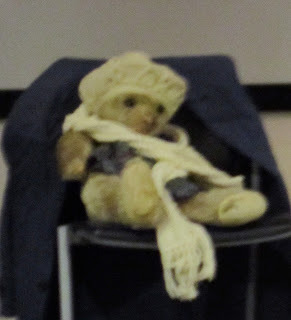
This one is Big Tom, who was quickly snaffled by Jane Ray and Sarah Mackintyre and dressed for winter weather. He is writing a sort of autobiography of bits and pieces, poems and reminiscences, which I predict will be a big seller.
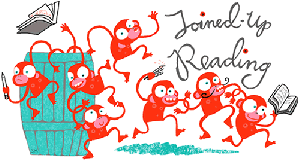 I know what it's like to Chair one of these conferences and Helena Pielichaty did a splendid job:
I know what it's like to Chair one of these conferences and Helena Pielichaty did a splendid job: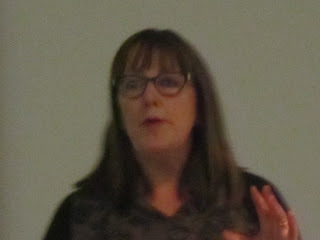
The reason that Helena looks fuzzy is that she didn't stay still long enough to me to get a better picture of her. Although it might be close to "write what you want," I think my favourite quotation from the weekend is Patrick Ness's: "I don't think you should give the reader what they want, I think you should make them want what you give them."
Happy writing everyone!
Published on September 22, 2012 11:13
September 13, 2012
A happy ending and a new beginning
 Just for once, I have a really lovely story to tell you about a library. Above, you see Eleanor Wheeler (nearly 16) and Amy Thomson (14), who are just two of the students at my local Secondary school who now have a library.
Just for once, I have a really lovely story to tell you about a library. Above, you see Eleanor Wheeler (nearly 16) and Amy Thomson (14), who are just two of the students at my local Secondary school who now have a library.But to impress you with just how unusual this is, I need to take you back in time to January 2011. There was a meeting in Oxford Town Hall to gather support for defending Oxfordshire libraries against savage cuts proposed by Council Leader Keith Mitchell*. I was there and heard Philip Pullman give this rousing speech. Afterwards, in a contribution from the floor, I mentioned that I had recently had a run-in with Mr Mitchell on Radio Oxford, because in his ignorance he had said that "all secondary school in the county have a library," which members of the public might use.
Now, I knew that my local Secondary school, Carterton Community College, had dispensed with its library and replaced the books with IT equipment so I wasn't going to let him get away with that. I mentioned this story at Oxford Town Hall and was approached afterwards by Rosemary Stables, the Head of English at CCC, who told me the wonderful news that under a new Headteacher, there was to be a new library there and she would be the Librarian.
On Monday I attended the opening of the excellent new library designed with the full involvement of students, and met Eleanor and Amy, both very keen readers. Headteacher Niall McWilliams said it was "the most important room in the school." And it was declared officially open by Professor Sir Tim Brighouse, who regularly ferries his grandson to the school from Oxford.
I looked round the bright and cheerful room, with its French windows opening on to a little patio garden, its cosy chairs, its stacking modular tables and its colour scheme (chosen by students) of purple white and green (shades of the Suffragists!). I looked at the well-stocked shelves of fiction and non-fiction. And I thought what a long way away it was from that dreadful time a few years ago when staff clambered into skips to save damp books.
So well done Carterton Community College, Niall McWilliams and his staff, especially Rosemary Stables, and well done all the parents and authors who have fund-raised or donated books. It all goes to show that stupid decisions can be reversed when there is a will to do so. I hope to be be visiting that library often.
 * Keith Mitchell has since stood down as Leader of Oxfordshire Council.
* Keith Mitchell has since stood down as Leader of Oxfordshire Council.
Published on September 13, 2012 05:35
September 2, 2012
Emily Windsnap is back!
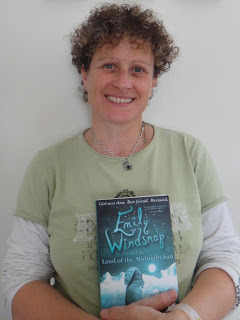 When I first met Liz Kessler, over ten years ago, she was living on a boat. She has a proper house now but still lives near the water - the sea, where she swims and surfs whenever the weather allows. In fact I have a sneaking suspicion that Liz is a part-time mermaid herself.
When I first met Liz Kessler, over ten years ago, she was living on a boat. She has a proper house now but still lives near the water - the sea, where she swims and surfs whenever the weather allows. In fact I have a sneaking suspicion that Liz is a part-time mermaid herself.Her official CV makes no mention of this:
LIZ KESSLER studied English at Loughborough University, has worked as a teacher and a journalist and has an MA in Creative Writing from Manchester Metropolitan University. After taking a year off to travel around Europe in a camper van, Liz now lives in St Ives, Cornwall.
But Liz's first published work was The Tail of Emily Windsnap, the story of a girl whose legs fuse into a fish's tail every time she enters the water. Imagine how alarming this is when it first happens in a school swimming lesson!
The fifth Emily Windsnap title is out this month and I asked Liz some questions about the book, which she was kind enough to answer.
Book Maven: I remember reading the first Emily Windsnap when the book came out in 2003 the year after we met. She was a little girl then and now in Land of the Midnight Sun, she has a boyfriend! Do you think your readers have been growing up alongside Emily and she has been keeping pace with them?
Liz Kessler: In Emily’s timeline, there is just under a year from the start of the first book to the end of this one. (What a busy year that has been for her - and you! BM) Aaron first showed up in the third book, and ever since then my readers have been wanting to see more of him (and asking if he is Emily’s boyfriend!) So I hope this means that Emily and my readers are on the same wavelength. I do often get emails asking for particular things to happen in the next book. Quite a lot of the time, these are things which I have already decided are going to happen, and it’s always a great relief when that happens. So yes, I think my readers and Emily seem to be keeping pace with each other quite well up to now. Let’s hope it continues!
BM: Can you explain what happens to Emily’s (and Aaron’s) clothes when they dive into the sea and adopt their Mer-forms? And are they then topless?
LK: It’s only ever adults who ask things like this! There are actually quite a few references to the ‘changing’ process throughout the series. I shall use your question as an excuse to quote one of them as an answer, taken from The Tail of Emily Windsnap.
‘So there I was, swimming like – well, like a fish! And in a way, I was a fish. My top half was the same as usual; skinny little arms, my fringe plastered to my forehead with seawater, black Speedo cozzy.
But then, just below the white line that goes across my tummy, I was someone else; something else. My costume melted away and, instead, I had shiny scales. My legs narrowed into a long, gleaming purple and green tail, waving gracefully as I skimmed along in the water.’ (Thank you for answering so patiently what I'm sure must be a very FAQ - at least from adults. BM)
BM: Neptune is in such a bad mood at the beginning of the story that he brings bad weather to the UK. You must have written this last year though. How did you KNOW we were going to have this awful summer?
LK: I know! Actually, I was reading from the first chapter at an event in Edinburgh last week and I could hear the rain pouring down around me as I read. I’ll try to write about beautiful sunny weather next time and see if that helps.
BM: There are five Emily Windsnap books now. Will there be more?
LK: I’ve actually stopped answering this question with any confidence. I was positive that there would only be three books, and then I was fairly sure that there would only be four. Now there are five – who knows? If people carry on wanting to read Emily’s stories, I’ll always be willing to write them. It’s such fun going on adventures with Emily. The research trips alone have given me some amazing times!
BM: Where did that lovely poem at the beginning come from? Did you write it yourself?
LK: Yes, I wrote it. (And thank you for saying it’s lovely.) It was at a workshop given by Lucy Coats at a Scattered Authors’ Society get together. She took us on a bardic journey, banging a drum and setting up a visualisation and then giving us a writing task. By the time I’d finished the visualisation, I completely ignored the task we were meant to do because all I wanted to do was write this poem. It was quite early on in my working out of the plot and was a pivotal and very exciting moment for me. (I envy you that experience. I too have tried Lucy's bardic journey but nothing happened to me. BM)
BM: And is Neptune’s brother Njord your own invention?
LK: Yes he is. I wanted to have this particular character in my book, and whilst thinking about names, I came across a Norse God called Njord. I knew instantly that he was the one. I tried to think of different names, as I knew that ‘Njord’ could be tricky for readers to know how to pronounce – but Njord was insistent that that was his name!
BM: Tell us a bit about researching this book. I think you took a ship to the Norwegian fjords. I wonder how many writers of fantasy for 8+ readers would be this thorough?
LK: I have this thing about my books. I always feel the need to go to the place where they are set – or as near to it as I can get. It feels like the only way to get right under the skin of the setting – and to get the best ideas for the plot. So I knew that I would have to see the Midnight Sun. A friend told me about a company called Hurtigruten, whose fleet of ships carry cargo, mail – and passengers – all around the northern coast of Norway. I looked into it and knew that I would have to do it.
It was one of the best research trips of my life – and one of the most beautiful experiences of my life too. Not only that, but it gave me absolutely loads of ideas for the book. If you’d like to see more about this inspiring trip, check out this slideshow I made on You Tube…
http://www.youtube.com/watch?v=Gck__wQieh0&feature=g-upl
Thank you for having me on your lovely blog!
Thank you for coming, Liz!

If you know, or are a big Emily Windsnap fan, you can enter a competition to win a special Sleepover pack by going to Liz's website and clicking on The Emily Windsnap Friendship Festival.
And just to confirm my suspicions about Liz's dual nature, here is a link to another clip.
What other children's writer would be surrounded by a huge pod of dolphins who are obviously saying, "Jump in and find your tail - we want to take you on a magical sea adventure"?
Published on September 02, 2012 07:27
August 27, 2012
Richard and the Drowndlings
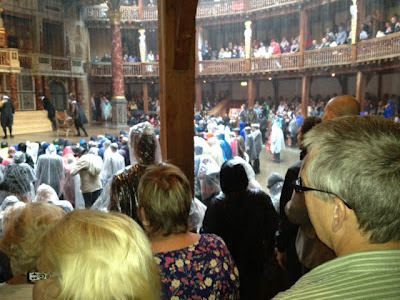 Audience at the GlobeYou aren't supposed to take photos at Shakespeare's Globe in London, but this is a picture of the audience not the players. It was at the end of the interval of the matinée of Richard the Third last Saturday.
Audience at the GlobeYou aren't supposed to take photos at Shakespeare's Globe in London, but this is a picture of the audience not the players. It was at the end of the interval of the matinée of Richard the Third last Saturday.No sooner had Mark Rylance started to utter the first lines of the play, in soliloquy - "Now is the winter of our discontent/made glorious summer ... " than the heavens opened and it POURED for the duration, enbellished by thunder and lightning. Indeed the rain was so loud that you couldn't always hear the actors.
In the interval the Ladies was apparently full of women trying to dry their sodden clothes under the hand-drier! You can see how many people had bought the flimsy £2.50 plastic macs but really it was such a soaker, only sou'westers would have been a protection.
The groundlings were troopers. The only gaps you can see are because some came and sheltered in the overhang of the galleries. I don't think anyone went home. And this production was sold out. I tried not to feel guilty in the back row of the Lower Gallery with somewhere to lean my back as well as out of the weather.
It's a play absolutely jam-packed with references to the sun and the weather.
says Richmond (later Henry Vll) just before the Battle of Bosworth Field - a forecast some were glad of.
And right on cue, after his victory, when Richmond said, "
Over on my other blog
But here I'm talking about the play not the man. Rylance's performance was extraordinary - a cross between an English king and Count Arthur Strong! And yet it worked, the bumbling and vague Duke of Gloucester, disingenuously claiming not that he was innocent but that he had killed his victims out of love - first for Anne Neville and then his niece, Elizabeth of York.
That Elizabeth didn't appear in this production, but her mother Elizabeth Woodville (Queen Elizabeth) did and was very well played by Samuel Barnett. For this was an all-male cast, as it would have been when performed in Shakespeare's day. Barnett was Posner in The History Boys (on stage and in the film) and he made an excellent woman. Lady Anne was less good, though she was a lovely ghost.
My favourite female character, Margaret of Anjou, "the She-wolf of France" had been cut altogether from this rather stripped down version of the text. And that was a shame. Not only do we lose,
but that wonderful incantation:
in the scene she plays with Richard's mother, the Duchess of York and Queen Elizabeth, widow of Edward lV. I missed that.
 image by Georges Seguin (Okki)Mark Rylance limped on with a white rose in his hand and gave it to a woman in the front row (I hope it survived the storm). The White Rose is the traditional symbol of the House of York so all the more puzzling that the programme carried the red rose on the front (a symbol of the House of Lancaster though the scene in which the rival factions pluck their blooms in "Henry Vl" was invented by Shakespeare).
image by Georges Seguin (Okki)Mark Rylance limped on with a white rose in his hand and gave it to a woman in the front row (I hope it survived the storm). The White Rose is the traditional symbol of the House of York so all the more puzzling that the programme carried the red rose on the front (a symbol of the House of Lancaster though the scene in which the rival factions pluck their blooms in "Henry Vl" was invented by Shakespeare).I wonder how often Shakespeare's groundlings were drenched to the skin? And how much fun the actors had improvising round the text on a really wet day?
Published on August 27, 2012 11:07
Mary Hoffman's Blog
- Mary Hoffman's profile
- 591 followers
Mary Hoffman isn't a Goodreads Author
(yet),
but they
do have a blog,
so here are some recent posts imported from
their feed.



